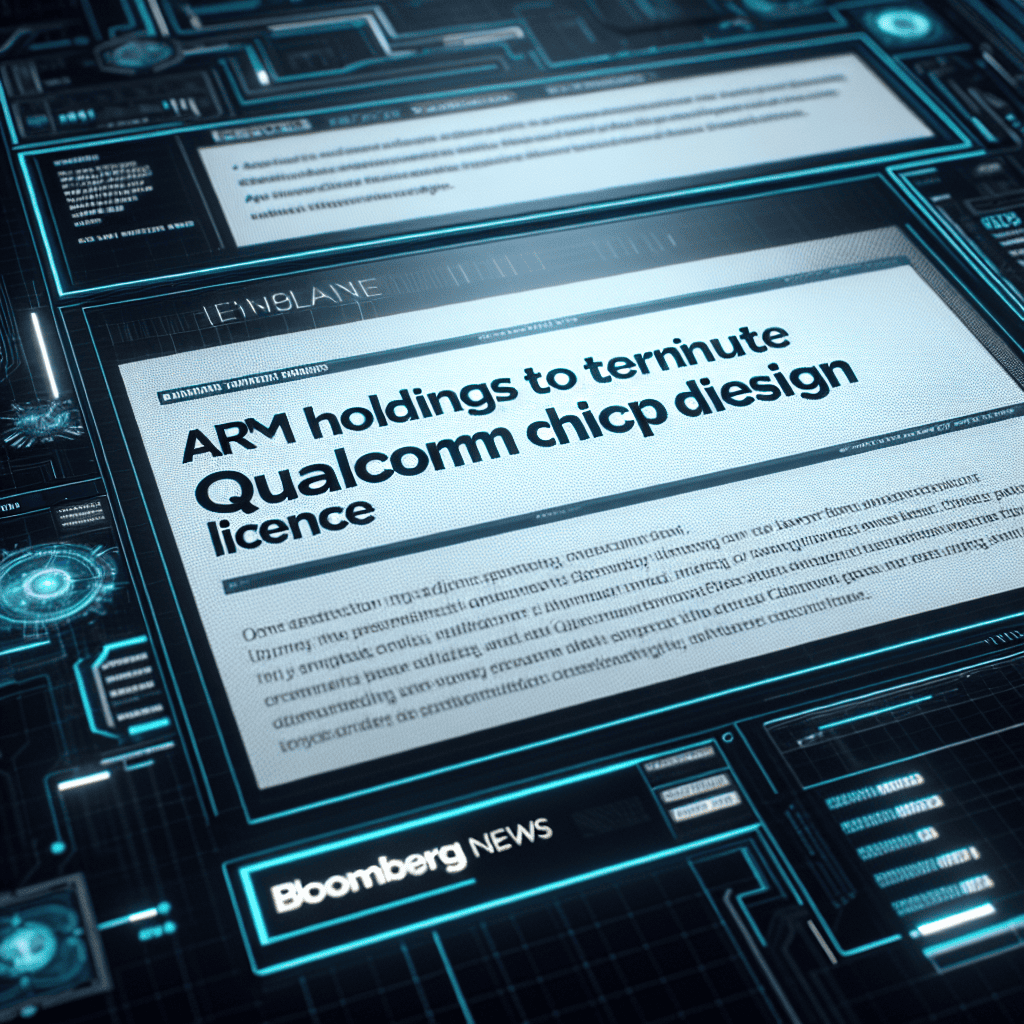“Arm Holdings Cuts Ties: Qualcomm’s Chip Design License Terminated, Reports Bloomberg.”
Introduction
Arm Holdings, a leading semiconductor and software design company, is reportedly planning to terminate its chip design license agreement with Qualcomm, according to Bloomberg News. This development marks a significant shift in the relationship between the two tech giants, potentially impacting Qualcomm’s ability to develop and produce its own custom chips based on Arm’s architecture. The move comes amid increasing competition and strategic realignments within the semiconductor industry, as companies seek to assert greater control over their technology stacks and intellectual property. The termination of the license could have far-reaching implications for both companies, as well as for the broader market, as they navigate the evolving landscape of chip design and manufacturing.
Impact Of Arm Holdings’ Decision On Qualcomm’s Future Chip Designs
Arm Holdings’ recent decision to terminate Qualcomm’s chip design license, as reported by Bloomberg News, marks a significant turning point in the semiconductor industry. This move could have profound implications for Qualcomm’s future chip designs and the broader tech ecosystem. As the industry grapples with rapid technological advancements and increasing competition, the termination of this license could reshape Qualcomm’s strategic direction and influence its market position.
To understand the potential impact of Arm Holdings’ decision, it is essential to consider the pivotal role that Arm’s architecture plays in Qualcomm’s chip designs. Arm’s architecture is renowned for its power efficiency and performance, making it a preferred choice for mobile devices, including smartphones and tablets. Qualcomm, a leading player in the semiconductor industry, has long relied on Arm’s architecture to develop its Snapdragon processors, which power a significant portion of the world’s mobile devices. The termination of the license could compel Qualcomm to explore alternative architectures or negotiate new terms with Arm, both of which could have far-reaching consequences.
Moreover, the decision comes at a time when the semiconductor industry is experiencing unprecedented demand and supply chain challenges. The global chip shortage has underscored the importance of securing reliable and efficient chip designs. For Qualcomm, losing access to Arm’s architecture could disrupt its product development timelines and affect its ability to meet market demands. This disruption could, in turn, impact Qualcomm’s relationships with device manufacturers and its competitive edge in the market.
In addition to the immediate operational challenges, the termination of the license could also influence Qualcomm’s long-term strategic planning. The company may need to invest in developing its own architecture or seek partnerships with other architecture providers. Such strategic shifts could require significant financial resources and time, potentially affecting Qualcomm’s innovation pipeline and market agility. Furthermore, the decision could prompt Qualcomm to reassess its research and development priorities, focusing on areas that align with its new architectural direction.
The broader tech industry could also feel the ripple effects of Arm Holdings’ decision. As a key player in the semiconductor market, Qualcomm’s strategies and innovations often set industry trends. Any changes in Qualcomm’s chip design approach could influence the design and functionality of future mobile devices, impacting consumers and manufacturers alike. Additionally, the decision could encourage other semiconductor companies to reevaluate their reliance on Arm’s architecture, potentially leading to increased diversification in chip design approaches across the industry.
While the termination of the license presents challenges, it also offers Qualcomm an opportunity to innovate and differentiate itself in the market. By exploring new architectures or developing proprietary solutions, Qualcomm could potentially create unique products that set it apart from competitors. This shift could foster a new wave of innovation in the semiconductor industry, driving advancements in areas such as artificial intelligence, 5G connectivity, and edge computing.
In conclusion, Arm Holdings’ decision to terminate Qualcomm’s chip design license is a pivotal moment for the semiconductor industry. The implications for Qualcomm’s future chip designs are significant, with potential impacts on its operational strategies, market position, and innovation trajectory. As the industry navigates this transition, the decisions made by Qualcomm and other stakeholders will shape the future of technology and its role in our increasingly connected world.
Legal Implications Of Arm Holdings Terminating Qualcomm’s License
The recent announcement by Arm Holdings to terminate Qualcomm’s chip design license has sent ripples through the tech industry, raising significant legal implications that warrant careful examination. This decision, reported by Bloomberg News, marks a pivotal moment in the relationship between two giants in the semiconductor industry. As the situation unfolds, it is crucial to understand the potential legal ramifications and the broader impact on the industry.
To begin with, the termination of Qualcomm’s license by Arm Holdings could lead to a series of legal disputes. Licensing agreements in the tech industry are often complex, involving numerous clauses that dictate the terms of use, intellectual property rights, and termination conditions. Qualcomm, a leading player in the mobile chip market, relies heavily on Arm’s architecture to design its processors. The cessation of this license could disrupt Qualcomm’s operations, prompting the company to seek legal recourse to protect its interests. In such scenarios, litigation could arise over the interpretation of the licensing agreement, particularly concerning the grounds for termination and any potential breach of contract.
Moreover, the termination could have significant implications for intellectual property rights. Arm Holdings, known for its innovative chip designs, licenses its technology to various companies, enabling them to develop their own products. The revocation of Qualcomm’s license raises questions about the protection of proprietary technology and the enforcement of intellectual property rights. Qualcomm may argue that it has invested substantial resources in developing products based on Arm’s architecture, and thus, the termination could be seen as an infringement on its ability to capitalize on its investments. This could lead to a protracted legal battle over the ownership and use of intellectual property, with potential ramifications for other companies that rely on similar licensing agreements.
In addition to the legal disputes, the termination of the license could have broader implications for the semiconductor industry. Qualcomm is a major player in the mobile chip market, and any disruption to its operations could have a ripple effect on the supply chain. This could impact not only Qualcomm’s business but also its partners and customers, including smartphone manufacturers and consumers. The uncertainty surrounding the license termination could lead to delays in product development and release, affecting the competitive landscape of the industry.
Furthermore, this development highlights the importance of strategic partnerships and the need for companies to diversify their technology sources. The reliance on a single supplier for critical technology can pose significant risks, as demonstrated by the current situation between Arm Holdings and Qualcomm. Companies may need to reassess their strategies and explore alternative partnerships to mitigate potential disruptions in their operations.
In conclusion, the decision by Arm Holdings to terminate Qualcomm’s chip design license presents a complex web of legal implications that could have far-reaching consequences for both companies and the broader semiconductor industry. As the situation evolves, it will be essential to monitor the legal proceedings and their impact on the industry. This case underscores the importance of clear and comprehensive licensing agreements, as well as the need for companies to navigate the intricate landscape of intellectual property rights and strategic partnerships. The outcome of this dispute could set a precedent for future licensing agreements and shape the dynamics of the tech industry for years to come.
How Arm Holdings’ Move Affects The Semiconductor Industry
Arm Holdings’ recent decision to terminate Qualcomm’s chip design license, as reported by Bloomberg News, marks a significant development in the semiconductor industry. This move is poised to have far-reaching implications, not only for the two companies involved but also for the broader landscape of semiconductor technology. As the industry grapples with rapid advancements and increasing competition, the termination of such a pivotal licensing agreement could reshape strategic alliances and innovation trajectories.
To understand the potential impact of Arm Holdings’ decision, it is essential to consider the role both companies play in the semiconductor ecosystem. Arm Holdings, a leader in semiconductor intellectual property, provides the architecture that underpins a vast array of devices, from smartphones to servers. Qualcomm, on the other hand, is a major player in the design and manufacturing of chips, particularly for mobile devices. The collaboration between these two giants has historically driven significant advancements in mobile technology, enabling the proliferation of powerful, energy-efficient devices.
The termination of Qualcomm’s license to use Arm’s designs could disrupt this synergy, compelling Qualcomm to explore alternative avenues for its chip designs. This shift may lead to increased competition as Qualcomm seeks to develop or acquire new technologies to maintain its market position. Consequently, other semiconductor companies might seize this opportunity to strengthen their own partnerships with Arm, potentially leading to a realignment of industry alliances.
Moreover, this development could accelerate innovation within the semiconductor sector. As Qualcomm navigates the challenges posed by the loss of Arm’s designs, it may invest more heavily in research and development to create proprietary architectures. This drive for innovation could spur technological breakthroughs, benefiting the industry as a whole. Additionally, other companies may be inspired to enhance their own R&D efforts, fostering a more dynamic and competitive environment.
However, the termination of the license also raises concerns about potential disruptions in the supply chain. Qualcomm’s reliance on Arm’s architecture has been a cornerstone of its product offerings, and any transition to new designs could lead to delays in product development and deployment. This uncertainty might affect device manufacturers and consumers, who have come to depend on the performance and reliability of Qualcomm-powered devices.
Furthermore, the geopolitical landscape adds another layer of complexity to this situation. The semiconductor industry is already navigating tensions between major global powers, with supply chain security and technological sovereignty becoming increasingly important. Arm Holdings’ decision could be interpreted as a strategic move to align with certain geopolitical interests, potentially influencing the global balance of power in semiconductor technology.
In conclusion, Arm Holdings’ termination of Qualcomm’s chip design license is a pivotal moment for the semiconductor industry. While it presents challenges for Qualcomm, it also opens the door to new opportunities for innovation and competition. As the industry adapts to this change, stakeholders will need to navigate a complex web of technological, economic, and geopolitical factors. Ultimately, the outcome of this development will shape the future of semiconductor technology, influencing how devices are designed, manufactured, and deployed across the globe.
Qualcomm’s Strategic Options After Losing Arm Holdings’ License

The recent announcement by Arm Holdings to terminate Qualcomm’s chip design license has sent ripples through the semiconductor industry, raising questions about Qualcomm’s strategic options moving forward. As reported by Bloomberg News, this development marks a significant shift in the longstanding relationship between the two tech giants. Qualcomm, a leading player in the mobile chipset market, has relied heavily on Arm’s architecture to power its Snapdragon processors, which are widely used in smartphones and other devices. The termination of this license could potentially disrupt Qualcomm’s supply chain and product development processes.
In light of this situation, Qualcomm must explore various strategic options to mitigate the impact of losing Arm’s license. One potential avenue is to accelerate its investment in custom chip design. By developing proprietary architectures, Qualcomm could reduce its dependency on external partners like Arm. This approach, however, would require substantial investment in research and development, as well as time to build the necessary expertise and infrastructure. Nevertheless, it could offer Qualcomm greater control over its product roadmap and differentiation in a competitive market.
Another option for Qualcomm is to seek alternative partnerships with other semiconductor companies. Collaborating with firms that offer similar capabilities to Arm could provide Qualcomm with the necessary technology to continue producing high-performance chips. For instance, companies like RISC-V and MIPS offer open-source architectures that could serve as viable alternatives. By diversifying its partnerships, Qualcomm could not only maintain its current product offerings but also explore new opportunities for innovation.
Moreover, Qualcomm might consider expanding its focus beyond mobile chipsets to other areas of the semiconductor market. The growing demand for chips in sectors such as automotive, IoT, and data centers presents a lucrative opportunity for Qualcomm to leverage its expertise. By diversifying its product portfolio, Qualcomm could reduce its reliance on any single technology or partner, thereby enhancing its resilience against future disruptions.
In addition to these strategic options, Qualcomm must also engage in proactive communication with its stakeholders. Transparent communication with investors, customers, and partners will be crucial in managing expectations and maintaining confidence in the company’s future prospects. By articulating a clear strategy and demonstrating its commitment to innovation, Qualcomm can reassure stakeholders of its ability to navigate this challenging transition.
Furthermore, Qualcomm’s legal team may explore the possibility of negotiating with Arm Holdings to reach a mutually beneficial agreement. While the termination of the license appears definitive, there may still be room for negotiation, especially if both parties recognize the value of their collaboration. A renegotiated agreement could potentially allow Qualcomm to continue using Arm’s architecture while addressing any concerns that led to the termination.
In conclusion, the termination of Qualcomm’s chip design license by Arm Holdings presents a significant challenge for the company. However, by exploring strategic options such as investing in custom chip design, seeking alternative partnerships, diversifying its product focus, and engaging in proactive communication, Qualcomm can navigate this transition effectively. While the road ahead may be complex, Qualcomm’s history of innovation and adaptability positions it well to overcome this hurdle and continue its leadership in the semiconductor industry.
Market Reactions To Arm Holdings’ Termination Of Qualcomm’s License
The recent announcement by Arm Holdings to terminate Qualcomm’s chip design license has sent ripples through the technology and financial markets, as reported by Bloomberg News. This decision marks a significant shift in the semiconductor industry, where both companies have long been pivotal players. Arm Holdings, a leader in semiconductor intellectual property, has been instrumental in providing the architecture that powers a vast array of devices, from smartphones to servers. Qualcomm, on the other hand, has been a dominant force in mobile chipsets, relying heavily on Arm’s designs to maintain its competitive edge. The termination of this license could have far-reaching implications for both companies and the broader market.
Initially, the market reaction was one of surprise and uncertainty. Investors and analysts alike are now grappling with the potential consequences of this move. For Qualcomm, the loss of Arm’s license could mean a significant disruption in its product development pipeline. The company may need to seek alternative architectures or invest heavily in developing its own, which could lead to increased costs and potential delays in product releases. This uncertainty has already been reflected in Qualcomm’s stock price, which experienced a noticeable dip following the announcement.
Conversely, Arm Holdings’ decision to terminate the license may be seen as a strategic maneuver to assert greater control over its intellectual property. By doing so, Arm could be positioning itself to negotiate more favorable terms or to explore new partnerships that align more closely with its long-term goals. This move could also be interpreted as a response to the rapidly evolving landscape of the semiconductor industry, where competition is intensifying, and innovation is paramount. As a result, Arm’s stock has shown resilience, with investors seemingly confident in the company’s strategic direction.
Moreover, this development has sparked discussions about the broader implications for the semiconductor industry. The relationship between Arm and Qualcomm has been emblematic of the collaborative nature of the tech ecosystem, where companies often rely on each other’s strengths to drive innovation. The termination of this license could signal a shift towards more independent and self-reliant strategies among major players. This could lead to increased competition, as companies strive to differentiate themselves through proprietary technologies and unique value propositions.
In addition to the immediate market reactions, there are potential long-term effects to consider. The semiconductor industry is already facing challenges such as supply chain disruptions and geopolitical tensions. The dissolution of such a significant partnership could exacerbate these issues, leading to further volatility in the market. Companies may need to reassess their strategies and partnerships to navigate this new landscape effectively.
In conclusion, Arm Holdings’ decision to terminate Qualcomm’s chip design license has introduced a new dynamic into the semiconductor industry, prompting varied reactions from the market. While Qualcomm faces potential challenges in adapting to this change, Arm appears to be leveraging the situation to strengthen its position. As the industry continues to evolve, the full impact of this decision will unfold over time, influencing strategies, partnerships, and competition within the sector. Investors and industry stakeholders will be closely monitoring developments, as the ramifications of this move could shape the future of semiconductor innovation and collaboration.
Potential Competitors To Arm Holdings In Chip Design Licensing
In the rapidly evolving landscape of semiconductor technology, Arm Holdings has long been a dominant force, particularly in the realm of chip design licensing. However, recent reports from Bloomberg News indicate that Arm Holdings is set to terminate its chip design license with Qualcomm, a move that could significantly alter the dynamics of the industry. This development raises questions about potential competitors that could emerge to challenge Arm’s supremacy in chip design licensing.
To understand the potential competitors to Arm Holdings, it is essential to first consider the unique position Arm has held in the market. Arm’s architecture is renowned for its power efficiency and versatility, making it the preferred choice for a wide range of applications, from smartphones to servers. Its licensing model allows companies to design their own chips based on Arm’s architecture, fostering innovation while maintaining a consistent technological foundation. However, as the industry matures and diversifies, other players are beginning to make their presence felt.
One potential competitor is RISC-V, an open-source instruction set architecture that has been gaining traction in recent years. Unlike Arm, which operates on a proprietary model, RISC-V offers a more flexible and cost-effective alternative. This open-source nature allows companies to customize and optimize their designs without the constraints of licensing fees, potentially appealing to startups and established firms alike. As more companies explore RISC-V’s capabilities, it could emerge as a formidable competitor to Arm, particularly in markets where cost and customization are critical factors.
Another contender is Intel, a company traditionally known for its dominance in x86 architecture. While Intel has primarily focused on its own proprietary designs, it has recently shown interest in expanding its reach into the Arm-dominated mobile and IoT sectors. Intel’s substantial resources and expertise in semiconductor manufacturing could enable it to develop competitive alternatives to Arm’s offerings. Moreover, Intel’s recent strategic partnerships and acquisitions suggest a concerted effort to diversify its portfolio and challenge Arm’s market share.
Additionally, companies like AMD and NVIDIA are also exploring opportunities to expand their influence in the chip design space. AMD, with its successful Zen architecture, has demonstrated its ability to innovate and compete with industry giants. Its experience in developing high-performance processors could position it as a viable alternative to Arm, especially in the high-performance computing sector. Similarly, NVIDIA’s advancements in GPU technology and its acquisition of Arm Holdings, although not completed, indicate its ambition to integrate and expand its capabilities in the chip design arena.
Furthermore, Chinese companies such as Huawei and Alibaba are investing heavily in developing their own chip design capabilities. With geopolitical tensions influencing the global semiconductor supply chain, these companies are motivated to reduce reliance on foreign technology. By developing indigenous solutions, they could potentially offer competitive alternatives to Arm’s designs, particularly within the Chinese market.
In conclusion, while Arm Holdings has been a dominant player in chip design licensing, the landscape is shifting. The termination of its license with Qualcomm could open the door for other competitors to gain ground. RISC-V’s open-source model, Intel’s strategic maneuvers, and the ambitions of companies like AMD, NVIDIA, and Chinese tech giants all contribute to a dynamic and competitive environment. As these entities continue to innovate and expand their capabilities, the future of chip design licensing promises to be both challenging and exciting, with Arm Holdings facing increased competition from a diverse array of players.
Historical Context: Previous Licensing Disputes In The Tech Industry
The recent announcement by Arm Holdings to terminate Qualcomm’s chip design license, as reported by Bloomberg News, has sent ripples through the tech industry, drawing attention to the historical context of licensing disputes that have shaped the sector. Licensing agreements are the backbone of technological innovation, allowing companies to leverage each other’s intellectual property to create cutting-edge products. However, these agreements can also become contentious, leading to disputes that have significant implications for the industry.
Historically, licensing disputes in the tech industry have often revolved around the balance of power between licensors and licensees. One notable example is the long-standing legal battle between Apple and Samsung, which began in 2011. The dispute centered on patent infringements related to smartphone designs and features, highlighting the complexities of intellectual property rights in a rapidly evolving market. This case underscored the importance of clear and mutually beneficial licensing agreements, as well as the potential for protracted legal battles when such agreements break down.
Similarly, the tech industry witnessed another significant licensing dispute between Oracle and Google over the use of Java APIs in the Android operating system. This case, which spanned nearly a decade, raised critical questions about the nature of software development and the extent to which programming interfaces can be protected under copyright law. The eventual resolution in favor of Google set a precedent for how software components are treated in terms of intellectual property, influencing future licensing negotiations and disputes.
In the semiconductor industry, licensing agreements are particularly crucial due to the complex and collaborative nature of chip design and manufacturing. Companies like Arm Holdings play a pivotal role by providing essential technology that powers a wide range of devices, from smartphones to servers. The decision by Arm to terminate Qualcomm’s license is reminiscent of past disputes in the semiconductor sector, where companies have clashed over access to critical technologies.
For instance, the legal battle between Intel and Advanced Micro Devices (AMD) in the early 2000s highlighted the competitive tensions in the chip industry. AMD accused Intel of anti-competitive practices, including coercing customers into exclusive agreements. The resolution of this dispute involved a significant settlement and a renewed focus on fair licensing practices, which have since influenced how companies negotiate and enforce their agreements.
The current situation between Arm and Qualcomm may similarly impact the industry, as it raises questions about the future of chip design and the dynamics of power between major players. As the tech industry continues to evolve, the importance of robust and transparent licensing agreements cannot be overstated. These agreements not only facilitate innovation but also ensure that companies can collaborate effectively without resorting to costly and time-consuming legal battles.
In conclusion, the decision by Arm Holdings to terminate Qualcomm’s chip design license is a reminder of the historical context of licensing disputes in the tech industry. From the high-profile battles between Apple and Samsung to the protracted legal proceedings between Oracle and Google, these disputes have shaped the landscape of technology and intellectual property. As the industry moves forward, the lessons learned from past conflicts will continue to inform the development of fair and equitable licensing practices, ensuring that innovation can thrive in a competitive and collaborative environment.
Q&A
1. **What is the main issue between Arm Holdings and Qualcomm?**
Arm Holdings is reportedly planning to terminate Qualcomm’s chip design license, which could impact Qualcomm’s ability to design and produce certain chips.
2. **Why is Arm Holdings considering terminating the license?**
The termination is likely due to disputes over licensing terms and potential breaches of contract, as Arm seeks to assert more control over its intellectual property.
3. **How might this affect Qualcomm’s business?**
Losing the license could hinder Qualcomm’s ability to develop new chips, potentially affecting its product lineup and market competitiveness.
4. **What are the potential legal implications of this move?**
The termination could lead to legal battles between Arm and Qualcomm, as Qualcomm may challenge the decision in court to protect its business interests.
5. **How has Qualcomm responded to these reports?**
Qualcomm may have issued statements defending its position and expressing intent to resolve the issue, though specific responses can vary.
6. **What impact could this have on the semiconductor industry?**
This dispute could lead to shifts in partnerships and collaborations within the industry, affecting supply chains and innovation dynamics.
7. **What are analysts saying about the situation?**
Analysts might express concerns about the uncertainty this creates for Qualcomm and the broader implications for the semiconductor market, while also speculating on potential resolutions.
Conclusion
Arm Holdings’ decision to terminate Qualcomm’s chip design license marks a significant shift in the semiconductor industry landscape. This move could potentially disrupt Qualcomm’s operations, as it relies on Arm’s architecture for its chip designs. The termination may lead to legal disputes or force Qualcomm to seek alternative solutions, such as developing its own architecture or partnering with other technology providers. This decision underscores the competitive and strategic tensions within the semiconductor sector, highlighting Arm’s intent to assert greater control over its intellectual property and licensing agreements. The outcome of this development could have broader implications for the industry, influencing market dynamics and future collaborations.





